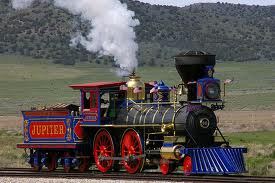Jupiter (officially known as Central Pacific Railroad #60) was a 4-4-0 steam locomotive which

made history as one of the two locomotives (the other being the Union Pacific No. 119) to meet at Promontory Summit during the Golden Spike ceremony commemorating the completion of the First Transcontinental Railroad.
The Jupiter was built in September 1868 by the Schenectady Locomotive Works of New York, along with three other engines, numbered 61, 62, and 63, named the Storm, Whirlwind, and Leviathan, respectively. These four engines were then dismantled and sailed to San Francisco, CA, where they were loaded onto a river barge and sent to the Central Pacific headquarters in Sacramento, then reassembled and commissioned into service on March 20, 1869.
The Jupiter was not Leland Stanford's original choice for transporting his party to the Golden Spike site. Originally, Stanford's train was to be pulled by another Central Pacific locomotive, the Antelope. For some distance, this train followed closely behind a regularly scheduled train pulled by the Jupiter. However, at one point the two trains were to go through a cut where a logging camp resided atop the hill. Apparently, either the Jupiter did not wear the proper flag to designate an extra following close behind, or the workers had failed to notice the flag. As a result, once the Jupiter passed, the workers rolled a large log down the mountain, which struck the Antelope. With the engine damaged, a message was sent to the upcoming station to hold the approaching train. There, Stanford's consist was added to the Jupiter's train.
The Southern Pacific had not acknowledged the Jupiter's significance until well after the engine had been scrapped. The railroad later used a stand-in for the Jupiter, usually Virginia and Truckee Railroad's Genoa locomotive, to celebrate the road's legacy at various events, such as the Chicago Railroad Fair.
In 1969, another stand-in for the Jupiter was placed on display, this one at the Golden Spike National Historic Site to celebrate the centennial of the Golden Spike. In this instance, the engine was portrayed by Virginia and Truckee Railroad's Inyo.
In 1974, the National Park Service had approached O'Connor Engineering Laboratories of Costa Mesa, California, to construct exact, full-size replicas of the Jupiter and Union Pacific 119. As was the case with the engines themselves, no drawings or plans of the engines survived, necessitating entirely new drawings to be produced based mostly on photos of the engines as well as research done on similar engines built around the same time. That same year, the existing engines portraying the Jupiter and 119 (the latter portrayed by the Virginia and Truckee Railroad's Dayton), had been sold to the state of Nevada, though they remained displayed at the Golden Spike NHS until the construction of the new replicas was complete.
The replicas were completed in 1979, and began operations on May 10 of that year, 110 years after the original Golden Spike ceremony, and continue to make demonstration runs.
Trivia[]
- Jupiter is Steamy and Puffy's brother
- He is also Union Pacific 119's best friend.
